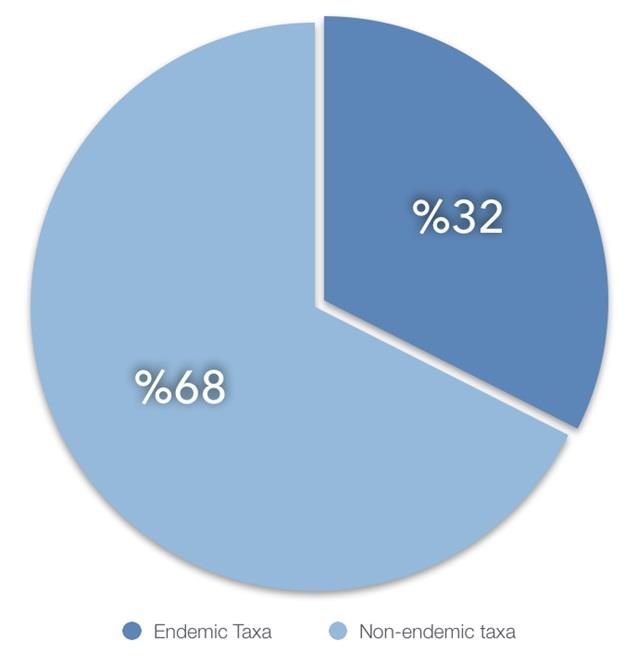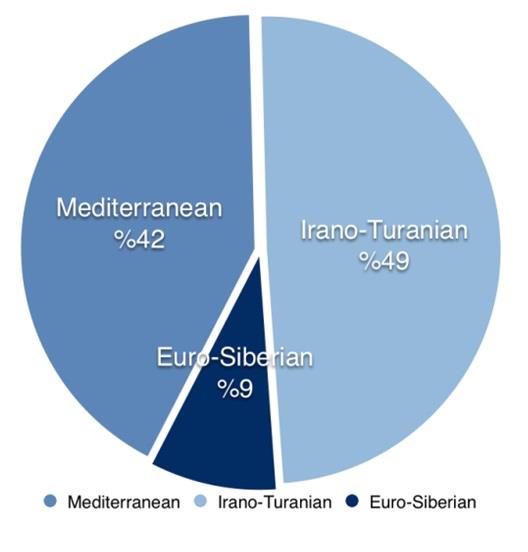Flora of Turkey and Conservation
Endemism in Turkey
Turkey has a very rich flora because of its geographical location, geological structure, climate diversity. The number of taxa in Turkey is around 11,400. The number of endemic taxa is around 3,700. Endemism rate is about 32%. It is not right to give exact figures for this number which is increasing every day.
Turkey has a very rich flora because of its geographical location, geological structure, climate diversity. The number of taxa in Turkey is around 11,400. The number of endemic taxa is around 3,700. Endemism rate is about 32%. It is not right to give exact figures for this number which is increasing every day.
Flora of Turkey and The East Aegean Islands (as known Flora of Turkey), which is composed of 11 volumes and first 9 volumes prepared by P.H. Davis and friends, is main source about flora of Turkey. The “Resimli Türkiye Florası”, which was first volume published in 2014 and planned to have 28 volumes in total, is a self-sacrificing product of Turkish scientists.
Turkey is one of the richest countries in terms of both species and endemic species within the Middle East and European countries. The reasons for this rich diversity can be listed below.
1) Climate differences (continental climate, ocean climate and Mediterranean climate)
2) Geological and geomorphological diversity
3) Rich water resources (sea, lake and stream)
4) Large height differences (sea level-5000 m)
5) Diversity of habitat, Include 3 phytogeographical regions (Euro-Siberian, Irano-Turanian, Mediterranean)
6) Anatolian diagonal
Distribution of Endemic Taxa in Geographic and Phytogeographic Regions
There are 826 endemic plants in the Mediterranean Region, 471 in the Eastern Anatolia Region, 335 in the Central Anatolia Region, 277 in the Black Sea Region, 171 in the Aegean Region, 102 in the Marmara Region and 64 in the Southeastern Anatolia Region. The remaining endemic plants are distributed in more than one region. Distribution of endemic plants by phytogeographic regions is shown in the graph.
Flora of Thrace (European Turkey)
European Turkey occupies a small part of Turkey, and has a surface area of 23.500 km2. It is situated north of the Sea of Marmara, which is connected to the Black Sea and Aegean Sea via the Bosphorus and Dardanelles respectively; together the sea and straits separate Europe from Asia. In comparison with Turkey’s general topography, Thrace generally has low elevations.
In the NE of the region the Yıldız Mountain range (Istranca Mountains) extends into SE Bulgaria, its highest point being Mahya Dag (1035 m). This range borders the Black Sea and represents a low continuation of Anatolia’s northern Black Sea Mountains. The range is largely composed of schists and is covered with forest vegetation, the humid northern slopes supporting Fagus orientalis forest and Rhododendron ponticum scrub.
In the SW of the region, the Ganos Mountains (Tekir Mountains) and KuruMountain (which continue southwards into the Gelibolu Peninsula) have typical Eastern Mediterranean landscape with Pinus brutia forest and macchie vegetation. The greater part of it is occupied by a gentle undulating lowland of less than 200 m elevation, drained by the Ergene (a tributary of Meriç) and almost entirely cultivated.
The Flora of European Turkey has attracted the attention of numerous botanists since the beginning of the 19th Century. Clarke (1816), Grisebach (1938-40), Formanek (1890) and Aznavour (1897-1913, published several records from European part of Istanbul) are main contributiors, whilst many additional species were coIlected by army personnel (Bulgarian, Russian and British) during the 1912-23 wars.
From the 1950s onwards, Turkish botanists have collected many specimens and made numerous records, of which the most valuable collections and records were made by A. Baytop and her colleques from ISTE Herbarium.
Apprxomately 2250 taxa (including subspecies and varieties) have been recorded from European Turkey, based on D. A. Webb’s, “The Flora of European Turkey”, P. H. Davis “Flora of Turkey and The East Aegean Islands”, publications (approximately 95 papers) and specimens kept in ISTE.
This does not compare of course with the more species-rich parts of Asiatic Turkey but diversity is comparatively high, given the relatively small area, where there is scarcely any land above 1000 m, low level of endemism and the fact that the native vegetation has been destroyed in parts and heavily managed for timber throughout much of the area. The explanation lies in the wide range in climatic conditions and the high diversity of habitats present in the area. Moreover, European Turkey is in effect the meeting-point of several floristic elements, notably the Mediterranean element, the Balkan-Central European element, the Sarmatian element and the Euxine element.
Over 300 species that are regarded as nationally rare or threatened occur within Turkish Thrace. Of these some 50 species are more abundant here than elsewhere on earth. Several habitats within the area are of high national, or even international, importance to nature conservation, notably:
◾the sand dunes along the Black Sea shoreline;
◾wetlands comprising flooded ‘longoz’ forests and reed-fringed coastal lagoons;
◾humid Thracian-euxinian forests on the northern slopes of the IstrancaMountains; and fragments of heathland and dry calcareous grasslands, exhibiting characteristics typical of the middle European steppes.
...



